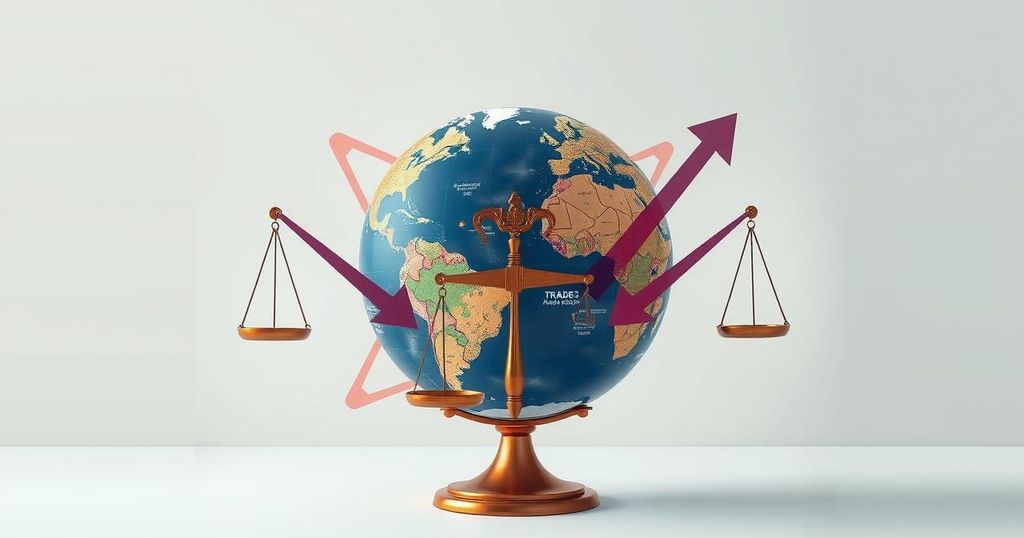Understanding Trump’s Tariff Policy and Its Impact on Global Trade

President Trump has imposed new tariffs on Mexico, Canada, and China, citing drug trafficking and immigration issues. These tariffs, which range from 10% to 25%, are expected to raise consumer prices and trigger retaliatory measures from these countries. Economists warn about potential inflation increases resulting from these trade policies.
President Donald Trump recently announced the imposition of tariffs on imports from Mexico, Canada, and China. He justifies these tariffs as necessary measures to protect American citizens from illegal immigration and the influx of drugs such as fentanyl. In addition, Trump hinted at potential tariffs on EU goods, while suggesting that a negotiation with the United Kingdom might be feasible.
Tariffs represent taxes levied on imported goods, varying from fixed amounts to percentages of the product’s value. The type Trump is introducing charges a percentage; for instance, a 25% tariff will apply to products valued at $4, adding an extra dollar to the cost. These costs are typically transferred to consumers, resulting in higher prices.
The Trump administration’s tariff policy targets Canada, Mexico, and China with 25% tariffs on the former two, and 10% on the latter. This move is a fulfillment of a campaign promise aimed at boosting domestic manufacturing and economic growth. Trump claims that these tariffs will also help combat fentanyl trafficking, which he associates with Canadian and Mexican suppliers.
In response to these tariffs, Canadian Prime Minister Justin Trudeau announced retaliatory tariffs on approximately $106.6 billion worth of US imports. Mexico’s President Claudia Sheinbaum instructed the Secretary of Economy to initiate a protective plan for their economic interests. China’s government expressed disapproval, stating that there are no winners in trade wars.
The tariffs will impact a range of products across multiple categories, notably increasing the cost of Mexican fruits, vegetables, and alcoholic beverages, as well as Canadian steel and lumber. The automotive industry may see the most significant effects, with potential price hikes of up to $3,000 per vehicle due to increased import taxes.
Regarding the UK and EU, Trump indicated that tariffs could soon affect both, criticizing their trade practices, although he agrees that a solution with the UK could be negotiated. UK officials believe they can argue for an exemption due to a favorable trade balance. However, the EU has warned it will respond firmly if tariffs are enacted.
Economists warn that the consumer will bear a substantial portion of these tariff costs, leading to inflation. Historical data shows that previous tariffs led to significant price increases for certain goods in the US market. Analysts predict that the new tariffs could raise inflation rates significantly, potentially reversing economic progress made earlier this year.
The issue at hand revolves around the implementation of tariffs by President Donald Trump as a policy tool to protect American economic interests and combat challenges such as illegal immigration and drug trafficking. Tariffs, as financial levies on imported goods, represent a contentious method employed by governments to encourage domestic production while inevitably influencing consumer prices. The reactions from Canada, Mexico, and China highlight the global interconnectedness of economies and illustrate the potential for trade disputes to escalate into broader economic conflicts.
In summary, the introduction of tariffs by President Trump on imports from Mexico, Canada, and China aims to bolster US manufacturing and address drug trafficking issues. While these tariffs might serve economic and political purposes, they risk inflating consumer prices and triggering retaliatory measures from affected countries. The prospect of increased inflation poses further challenges for the US economy, emphasizing the intricate balance between protecting national interests and sustaining a healthy trade environment.
Original Source: www.bbc.com








